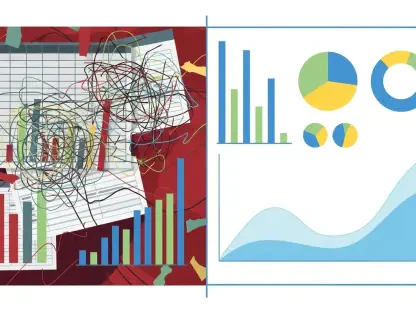In recent years, GLP-1 drugs have emerged as a significant force transcending their initial purpose of weight loss. While their primary application lies in aiding substantial weight reduction, these medications are now recognized for their extended impacts on workplace environments and societal perceptions, particularly concerning women. The effects of these drugs are pivotal, not only in reshaping the physical landscape but also in redefining how women perceive themselves and are perceived by others in professional settings. This development presents a deeper narrative of transformation in workplace dynamics, particularly highlighting shifts in respect, opportunities, and economic ramifications.
The Social Weight of GLP-1 Medications
Shift in Workplace Perception
The role of GLP-1 drugs in altering workplace perceptions is increasingly evident. These medications have contributed to significant weight loss, which, in turn, affects women’s confidence and self-esteem in professional spheres. Such psychological shifts are crucial, as they often lead to a perceptible increase in respect among colleagues. The enhanced confidence aids in navigating workplace interactions with greater ease and assertiveness, fostering an environment where one’s contributions are more readily acknowledged and valued. This changing perception signifies an evolving workplace culture, suggesting that while weight bias persists, efforts to promote self-esteem may bridge gaps in professional discourse and collaboration.
Beyond individual transformation, this increased respect also challenges traditional gender dynamics within the workplace. Women who have experienced weight loss through GLP-1 treatment often find themselves regarded with renewed consideration, as if shedding a veil that once obscured their capabilities. This shift hints at an underlying recognition of merit over superficial assessments, yet it also underscores the enduring challenge of disentangling professional respect and personal appearance. As more women experience these nuanced changes, the broader conversation on gender equity in the workplace garners momentum, highlighting both progress made and the journey yet ahead.
Weight Bias and Inclusivity Challenges
Despite the positive shifts in perception, the issue of weight bias looms large in workplace environments. Physical appearance often wields undue influence over professional dynamics, overshadowing individual capabilities and contributions. This persistent bias presents significant challenges to achieving genuine inclusivity and equitable career progression. The prejudicial regard based on physique undercuts initiatives aimed at fostering a meritocratic culture, where advancement is solely dependent on skill, performance, and potential. As women navigate this complex landscape, the tension between appearance-influenced perceptions and objective assessments of competency becomes increasingly apparent.
Efforts to mitigate weight bias in workplaces necessitate a thorough reevaluation of existing frameworks and policies designed to promote inclusivity. Addressing these deeply entrenched biases requires concerted efforts to educate and inform, seeking to redefine inclusivity in a manner that values diversity beyond surface-level attributes. The transformative potential of GLP-1 drugs could be further leveraged to inspire lasting cultural changes, with the aim of fostering an environment where all individuals, regardless of appearance, are accorded equal opportunities to thrive and contribute. Such shifts are imperative for cultivating workplaces that truly embody principles of fairness and equality.
Changing Career Landscape
Empowerment Through Self-Image
GLP-1 medications have played a significant role in enhancing women’s self-image, empowering them to aspire to leadership roles within their respective fields. This newfound empowerment stems from the physical transformation that accompanies weight loss, generating a ripple effect that positively influences their confidence and ambitions. Women across various demographics have reported feeling emboldened to capitalize on professional opportunities previously perceived as inaccessible. There is a noted generational divide in the responses to this empowerment, with millennials and Gen Z women experiencing particularly profound boosts in self-esteem and readiness to take on leadership challenges.
The noticeable differences among generations suggest that younger women are more adept at leveraging physical transformation into tangible professional growth. This distinction may be attributed to evolving societal narratives that celebrate diversity and inclusivity, encouraging younger generations to challenge traditional gender roles and stereotypes. By embracing these cultural shifts and the confidence derived from personal achievements, women across age brackets are increasingly positioned to redefine workplace hierarchies and entrepreneurial ventures. This empowerment through self-image underscores a broader movement toward more diverse and representative leadership structures.
Disconnect Between Respect and Advancement
While the increase in personal respect garnered through GLP-1-related weight loss is evident, a tangible disconnect persists between respect and actual career advancement. Women experiencing these shifts often find recognition from peers does not seamlessly translate into promotions or expanded responsibilities. The disparity highlights a critical systemic issue where social validation and recognition fall short of effecting concrete changes within workplace hierarchies. Even as individual accomplishments and transformations earn esteem, organizational recognition in the form of promotions and leadership roles remains elusive.
This disconnect is punctuated by the reality that promotions often hinge on long-standing workplace structures, performance metrics, and entrenched hierarchies rather than appearance-driven attitudes. To align recognition with opportunity, systemic changes are required, focusing on equitable criteria for career progression. Such changes would ensure that respect resulting from personal transformations finds meaningful expression in career trajectories, rather than being confined to mere acknowledgment. Addressing this gap is crucial for advancing equity in career opportunities and dismantling barriers that hinder women’s professional growth.
Economic Implications of GLP-1 Drugs
Healthcare Cost Reduction
The use of GLP-1 medications has had a far-reaching impact on healthcare expenditures, offering potential reductions in costs associated with chronic health conditions. These medications have been shown to significantly decrease the incidence of severe cardiovascular events, a benefit that reflects across the healthcare spectrum. By reducing such events, GLP-1 drugs contribute not only to improved personal health outcomes but also to substantial savings in long-term medical costs. This dual benefit enhances the appeal of incorporating these medications into broader health strategies, aiming to mitigate the economic burden of widespread conditions such as obesity and diabetes.
The potential for long-term healthcare cost improvements aligns with larger systemic goals of reducing the fiscal pressure exerted by chronic illnesses. The associated reductions in blood pressure and blood sugar levels among users further complement the economic advantages by curbing the progression and complications of related health issues. Consequently, integrating GLP-1 drugs into healthcare frameworks represents a promising strategy for managing escalating healthcare costs while promoting healthier population outcomes. The interplay between individual health benefits and macro-level economic savings underscores the transformative potential of these medications in reshaping the landscape of public health strategies.
Corporate Health Strategies
Organizations like Aon are spearheading strategic initiatives to incorporate GLP-1 drugs within their health benefit plans, marking a pivotal shift towards comprehensive health solutions aimed at enhancing workforce productivity. These pilot initiatives reflect a broader trend where employers are actively seeking innovative approaches to promote employee well-being. By offering GLP-1 medications as part of their health benefits, companies are acknowledging the multifaceted nature of employee health, which encompasses physical, mental, and emotional aspects. Such forward-thinking strategies address healthcare challenges holistically, recognizing that the well-being of individuals directly correlates with organizational performance and productivity.
The integration of GLP-1 drugs in corporate health plans also raises important questions about cost-effectiveness, accessibility, and the role of employers in facilitating comprehensive health solutions. Aon’s approach highlights the potential for symbiotic relationships between corporate structures and employee health outcomes, where investments in proactive health measures yield dividends in productivity and job satisfaction. As more companies explore similar strategies, the corporate landscape could undergo significant changes, emphasizing the critical interplay between employee health benefits and business success. This evolution in corporate health strategies signals a new era in aligning business objectives with employee-centric approaches.
Broader Impacts and Systemic Change
Societal Shifts and Structural Adjustments
The broader societal implications of GLP-1 drugs extend beyond individual transformations, heralding potential shifts in workplace culture and structural dynamics. The ongoing conversations about inclusivity highlight the necessity for addressing entrenched biases that impede equitable advancement within professional environments. As GLP-1 medications contribute to changing perceptions and self-esteem, they serve as a catalyst for re-evaluating cultural norms and practices that govern workplace interactions and progression. The ripple effects of these medications underscore a call to action for companies to foster inclusive environments that prioritize diversity beyond superficial attributes.
Addressing these structural adjustments entails rethinking policies, practices, and attitudes that historically perpetuate disparities in professional opportunities. The transformative potential of GLP-1 drugs can serve as a launchpad for broader initiatives aimed at creating equitable workplaces that celebrate individual differences and nurture talents irrespective of physical characteristics. These societal shifts necessitate a collective effort to challenge biases and cultivate environments where meritocratic ideals thrive. By aligning cultural changes with the physical and psychological impacts of GLP-1 medications, organizations can drive meaningful progress toward more diverse and inclusive workplaces.
Future Directions in Workplace Inclusivity
In recent times, GLP-1 medications have gained notable prominence, extending beyond their primary function of promoting weight loss. Initially developed to help with significant weight reduction, these drugs are now recognized for their broader influence on workplace environments and societal views, especially pertaining to women. The effects of GLP-1 drugs are critical, not just in altering physical appearances but also in transforming how women perceive themselves and are perceived by colleagues and superiors in professional settings. This development unfolds a complex narrative of change within workplace dynamics, illuminating shifts in respect, opportunities, and economic impacts. As women experience these changes, it challenges existing perceptions and norms, potentially leading to greater empowerment and equity in professional environments. Meanwhile, society observes and responds to these transformations, sparking discussions about beauty standards and the role of medications in shaping modern identities.









